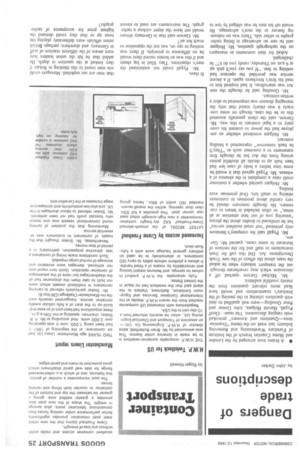Container Transport
Page 27

If you've noticed an error in this article please click here to report it so we can fix it.
by Roger Howell
H.W.P. Twisdock for US
THE H.W.P. retractable container-twistlock is to be made in America under licence. This was announced by Mr. Brian Butterfield, sales director of H.W.P. Engineering Co. Ltd.— an associate of Transport and Chemical Engineering Ltd., when he recently returned from a 10-day visit to the USA.
Negotiations with interested US companies resulted from the recent H.W.P. display at the International Container Services and Equipment Exhibition, Baltimore. Visitors to the stand said that the twistlock had no equal in the United States.
Fully retractable, the 1-I.W.P. product involves no springs, and features instant locking and retractability by means of a fitted handle. It allows a platform vehicle safely to carry ISO containers, or alternatively to be used on ordinary geheral haulage work with a fullyflush deck.
Increased access by Crane Fruehauf
LATEST MODEL of the smooth-skinned Crane-Fruehauf KA2 dry-freight container incorporates a new high-strength rolled steel rear corner post. This provides a full 93in. clear door opening, within the overall recommended ISO width of 96in., hence giving excellent container access and inside width without any loss of strength.
Crane Fruehauf claims that the new rolled steel post innovation provides significantly better performance under racking forces than conventional fabricated posts, plus savings in weight. The shape of the new post also provides a greater welded area, giving a greater tie between the top and bottom of the container to counter both lifting and racking forces.
The post incorporates a number of protective features, one of which is a rolled recessed flange for side wall panel attachment which gives protection to rivets and panel edges.
Manchester Liners report
TWO YEARS ago Manchester Liners Ltd. had six containers; at the beginning of 1967 it had been using 1,000, now it was operating over 2,000 units. And according to Mr. R. B. Stoker, chairman, speaking at the 70th e.g. rn.. these acquisitions had been part of an essential build-up to the start of a fully cellular weekly container service, inaugurated recently with the my Manchester Challenge (CM Nov 8).
Mr. Stoker particularly referred to carrying containers in traditional vessels which were not built to take them–the shipowner had all the disadvantages but none of the advantages of container operation. Quick turn-round was not achieved, damages were excessive and stowage of normal cargo impeded.
Such conditions made hiring of containers a less attractive proposition, particularly in a period of dear money.
Nevertheless, Mr. Stoker thought that the supply of containers to customers was an essential service.
Mentioning that the problem of turning round conventional vessels was one reason why forecast profit had not been achieved. Mr. Stoker referred to labour shortages in the UK, and also low productivity and retrospective wage increases at the Canadian end.












































































































